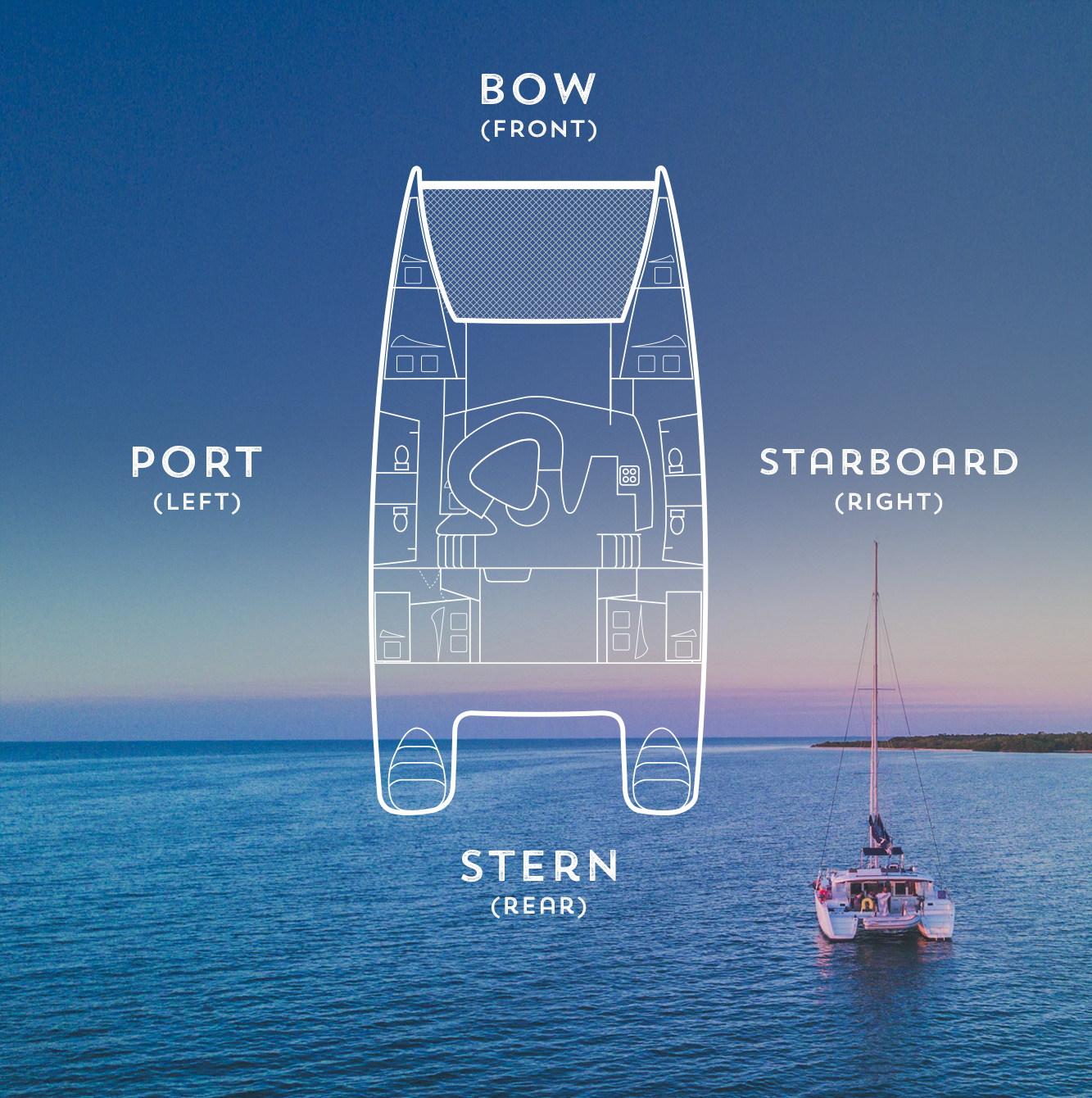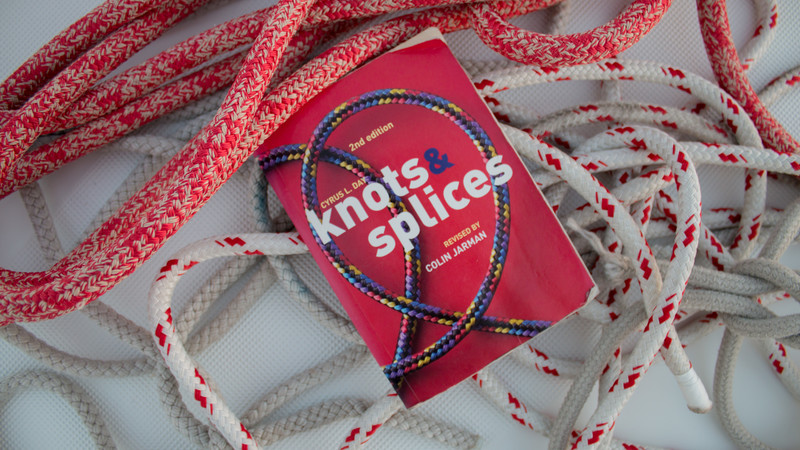One of the beauties of sailing is that it can look so simple. Clipping across the open waters on a sailing adventure, sun on your face, wind in your hair, the weathered pages of that copy of Moby Dick gently turning in the sea breeze… It looks effortless, carefree, and – well – like plain sailing.
But just like ballet, horse riding or cooking a soufflé, there’s a lot of technique and training that goes into seafaring. How do you tell your port side from your starboard? What does it really mean if the captain likes the cut of your jib? How do you tie a cleat hitch?
If you’re just starting to cut your teeth on life at sea, here’s your essential guide to sailing that every beginner should know.
Getting to know the boat
Boat, catamaran, canoe or dinghy, the same international terms apply to every part of the vessel. These are the big ones to remember:
Port and Starboard
Looking forward to the front of the boat, your Port side refers to anything to the left of the boat. By contrast, Starboard refers to anything to the right. These terms may take a little while to get used to, but they were created to help sailors understand instructions no matter which direction they were facing on the boat.
Bow and Stern
The bow refers to the front of the boat while the stern is the rear. Try and think of the boat as being split in two, anything in the front half of the boat can be referred to as ‘forward’ and anything in the second half is called ‘aft’ or ‘astern’.
Helm
The helm is where you’ll find the skipper steering the boat. On larger boats, the helm is usually located higher up on deck, making it a good place to hang out if you’re feeling seasick (Link: /adventures/five-ways-to-stop-seasickness).
Keel
Hopefully you’ll never see the keel of a boat while you’re on board. That’s because it’s a long, heavy fin found under the bottom of the boat. It sticks into the water and gives the boat stability. This out-of-sight and underappreciated invention is the reason modern boats are very difficult to capsize.

A deck plan of Intrepid’s catamarans.
Tack
The word tack can be used in two different ways. The first is as a verb, meaning to change the direction of the boat’s bow through the wind. The second is as a noun, referring to the boat’s course and bearings, relative to wind direction (usually done by referencing the port and starboard sides of the boat). For instance, if the wind is blowing over your starboard side, you’re on a starboard tack.
Jibe
If a tack is leading the front of your boat through wind, then a jibe is leading with your behind – that is, changing the direction of the boat’s stern through the wind. Choosing to change direction using the bow or stern comes down to circumstances, such as direction of the wind, what’s around the boat and so on.
Lines
When you’re at sea, you refer to the boat’s (many) ropes as lines. Try to be mindful of where you walk on deck so you don’t accidentally trip on them.
RELATED CONTENT: FIVE WAYS TO STOP SEASICKNESS
Cleat
Cleats are the silver handles sticking up from the deck around the boat. They’re actually used to tie cleat knots (see below) and secure lines from the boat to the harbour.
Mainsail
The largest and most important sail on any boat is called the Mainsail. It’s the big triangular wedge of sheeting you’ll find just after the boat’s mast. The mainsail is weighed down with a thick, heavy pole at its base called a boom. Historically, the boom has also been referred to as the ‘widow maker’, due to the number of sailors killed by the mainsail pivoting in the wind and knocking people on the noggin (and often overboard), so remember to watch your head.
Jib
Playing second fiddle to the Mainsail is the jib. The jib does not have a boom and it can usually be found forward of the mast. Back in the days of pirates and conquests, the shape of the jib sail indicated the vessel’s nationality and whether it was an enemy or ally. Back then, liking the ‘cut of someone’s jib’ meant you saw that sailor as a friend, but these days the term refers to whether the jib has been unfurled correctly with the wind.
Knot so fast – basic knot-tying for beginners
The figure-eight knot
This handy knot was designed to keep ropes from coming loose and running out of retaining devices, such as carabiners during rock climbing. If tied correctly, the figure-eight knot will jam under pressure. The figure-eight knot is also referred to as a Savoy knot, Flemish knot and double stopper.
To tie, create a loop in the line by bringing the tail of the rope back over itself. Then thread under the rope and back through the loop to create a figure-eight pattern. Pull tight to close.
The reef knot
It looks complicated, but a reef knot is as easy as tying your shoelaces. To tie, take two ropes and cross them over each other to form a half-knot. Then cross them over each other again and pull the ends tight. Anxious sailors might want to make the knot extra secure by adding another half-knot.
The reef knot is also referred to as a square knot and Hercules knot. Ideally you should use the same piece of rope to make this knot, instead of combining two different types of rope.
The sheet bend knot
The sheet bend knot is handy when you have two pieces of differently sized ropes (but it works just as well tying together the same rope). To tie, form a loop in one of the ropes (usually the thicker one) and hold it in your hand. Pass the other thinner rope through the loop, then behind the two strands of the thicker rope and back under the part of itself sticking through the loop.
The sheet bend knot is also referred to as becket bend, weaver’s knot and weaver’s hitch.
Bowline knot
It’s no surprise what the bowline knot was used for – securing bow lines to ports and harbours. This fastening knot is quick to make and can be used as a rescue rope when tied around a person.
To tie, make a small loop in the rope, leaving enough rope behind to create the desired size of the eventual knot. Pass the tail of the rope through the loop, wind it under the stand and then pass it back through the loop to close. One easy way to think of it is as a rabbit hole with a tree above it, the tree being represented by the standing rope. The rabbit jumps up through its hole, passes behind the tree and then jumps back into its rabbit hole.
Cleat hitch knot
The cleat hitch knot secures the boat’s line to a cleat and allows sailors to moor their boats. It might look simple, but if it isn’t tied properly you might spot your boat floating away from the harbour without you.
To tie, bring the line to the furthest end of the cleat from the harbour (also called the far horn), then wind it under the far horn and back around to the opposite side (the near horn). Bring the line up over the near horn and start to coil it in figure eights between the far and near horns. Make multiple figure eight loops to secure the knot.
Keen to learn more? Jump on one of our sailing adventures and our skippers will teach you all the tricks of the trade.




